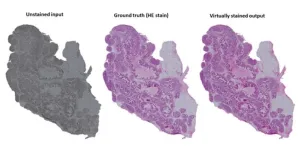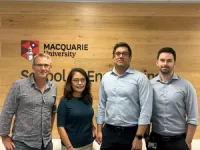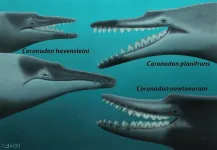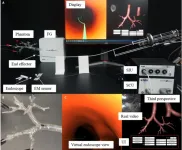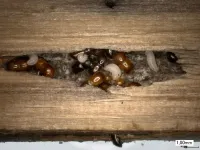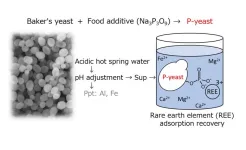(Press-News.org) Researchers from the University of Eastern Finland, the University of Turku, and Tampere University have developed an artificial intelligence-based method for virtual staining of histopathological tissue samples as a part of the Nordic ABCAP consortium. Chemical staining has been the cornerstone of studying histopathology for more than a century and is widely applied in, for example, cancer diagnostics.
“Chemical staining makes the morphology of the almost transparent, low-contrast tissue sections visible. Without it, analysing tissue morphology is almost impossible for human vision. Chemical staining is irreversible, and in most cases, it prevents the use of the same sample for other experiments or measurements,” says University Researcher and Vice Director of the Institute of Biomedicine at the University of Eastern Finland Leena Latonen, who led the experimental part of the study.
The artificial intelligence method developed in this study produces computational images that very closely resemble those produced by the actual chemical staining process. This virtually stained image can then be used for inspecting the morphology of the tissues. Virtual staining reduces both the chemical burden and manual work needed for sample processing while also enabling the use of the tissue for other purposes than the staining itself.
The strength of the proposed virtual staining method is that it requires no special hardware or infrastructure beyond a regular light microscopy and a suitable computer.
“The results are very widely applicable. There are plenty of topics for follow-up research, and the computational methods can still be improved. However, we can already envision several application areas where virtual staining can have a major impact in histopathology,” says Associate Professor Pekka Ruusuvuori from the University of Turku, who led the computational part of the study.
Ground-breaking research with international funding
One of the key factors enabling the study was the consortium funding obtained from the ERAPerMed joint transnational call. The ABCAP consortium consists of Nordic research groups developing artificial intelligence-based diagnostics of breast cancer towards personalised medicine and is funded by ERAPerMed, Nordic Cancer Union and the Academy of Finland. Both Latonen and Ruusuvuori lead their own subprojects.
“This research is truly cross-disciplinary. Without consortium funding, it would be very difficult to find enough resources for both the experimental laboratory work and the computational effort to enable studies like this,” acknowledge Ruusuvuori and Latonen.
This cross-disciplinary research is based on expertise in tissue biology, histological processes, bioimage informatics and artificial intelligence. The first part of the two-phase study focused on optimising the tissue sample processing and imaging steps, and was carried out by Doctoral Researcher Sonja Koivukoski from the University of Eastern Finland. Systematic assessment of histological feasibility was a unique component in the study.
“Development of computational methods using artificial intelligence often lacks proper assessment of the feasibility from the perspective of the end user. This may lead to methods being developed and published but eventually not really used in practice. Therefore, it is especially important to combine both computational and domain-based knowledge already in the development phase, as was done in our study,” state Latonen and Koivukoski.
Great potential of computational methods
Deep neural networks learning form large volumes of data have rapidly transformed the field of biomedical image analysis. In addition to traditional image analysis tasks, such as image interpretation, these methods are also well suited for image-to-image transforms. Virtual staining is an example of such a task, as was successfully shown in the two published parts of the work. The second part focused on optimising virtual staining based on generative adversarial neural networks, with Doctoral Researcher Umair Khan from the University of Turku as the lead developer.
“Deep neural networks are capable of performing at a level we were not able to imagine a while ago. Artificial intelligence-based virtual staining can have a major impact towards more efficient sample processing in histopathology,” says Khan.
In addition to the artificial intelligence algorithms, the key to success was the availability of high-performance computing services through CSC.
“In Finland, we have an excellent infrastructure for parallel high-performance computing. Computationally intensive research like this would not be possible without the capacity provided by CSC,” says Ruusuvuori.
The results of the study were published in two international peer-reviewed journals, Laboratory Investigation and Patterns.
END
Researchers developed an AI-based method to replace chemical staining of tissue
2023-04-14
ELSE PRESS RELEASES FROM THIS DATE:
Rescuing corneal cells from death with the help of mitochondria
2023-04-14
Québec City, April 14, 2023 - Fuchs' endothelial corneal dystrophy, a degenerative eye disease, causes progressive vision loss that can induce blindness. It is the leading cause of corneal transplantation, but the scarcity of grafts hinders its treatment. A research team from Université Laval and Université de Montréal has identified a way to slow the disease and even avoid transplantation if diagnosed at an early stage.
In people with the disease, the endothelial cells at the back of the cornea die more quickly than in healthy people. "Everyone loses them at a slow rate, slow enough to make it to the end of our lives ...
New specimens and species of the Oligocene toothed baleen whale Coronodon from South Carolina and the origin of Neoceti
2023-04-14
A new study published in the journal PeerJ by Robert W. Boessenecker (CofC), Brian L. Beatty (NYIT), and Jonathan H. Geisler (NYIT) reports a wealth of new fossils of the early toothed baleen whale Coronodon from Oligocene (23-30 million years old) rock layers near Charleston, South Carolina. These include five new skulls, representing two new species: Coronodon planifrons and Coronodon newtonorum, and young juveniles of Coronodon havensteini – first named from a single skull by this team in 2017. Coronodon is one of the most primitive members ...
New family of wheel-like metallic clusters exhibit unique properties
2023-04-14
While the wheel does not need to be reinvented, there are benefits to the development of new nano-wheels, according to a multi-institute research team based in China. The group fabricated a novel family of metallic compounds, each of which exhibit unique properties desirable for next-generation technologies, such as advanced sensors.
Their findings were made available online on March 12 in Polyoxometalates.
“Polymetallic complexes are of great interest not only for their appealing molecular structure but also ...
How drugs get into the blood
2023-04-14
There is a need for new drugs. For example, many of the antibiotics that we have been using for a long time are becoming less effective. Chemists and pharmaceutical scientists are frantically searching for new active substances, especially those that can penetrate cell membranes, as these are the only ones that patients can take orally in the form of a tablet or syrup. Only these active ingredients pass through the intestinal wall in the small intestine and enter the bloodstream to reach the affected area in the body. For active ingredients that cannot penetrate the cell membrane, physicians have no choice but to inject them directly into ...
A novel robotic bronchoscope system for navigation and biopsy of pulmonary lesions
2023-04-14
Cancers are notoriously known for their high mortality rate and increasing incidence worldwide. Among them, lung cancer is arguably one of the most devastating ones. According to the World Cancer Research Fund International, lung cancer was the second most common cancer around the world in 2020, with more than 2.2 million new cases and 1.8 million deaths.
However, lung cancer, like other cancers, is easier to treat if caught earlier. “The reported 1-year survival rate for stage V is just 15% to 19% compared with 81% to 85% for stage I, which means that the early ...
Black cancer patients 71% more likely to experience heart damage following chemotherapy treatment
2023-04-14
Chemotherapy is associated with an increased risk of treatment-related heart damage, including heart failure and cerebrovascular disease, for many patients. But a new meta-analysis, presented at the American College of Cardiology’s Advancing the Cardiovascular Care of the Oncology Patient 2023 conference, finds that Black patients or patients of African ancestry have 71% higher odds of cardiotoxicity following cancer treatment compared to White patients.
Cardiotoxicity is any heart damage stemming from cancer treatment or drugs, including ...
Optica Publishing Group announces launch of Optica Quantum
2023-04-14
WASHINGTON—On World Quantum Day, Optica Publishing Group announced it will begin publishing a new journal in September 2023 dedicated to highly selective results in quantum information science and technology (QIST). The new journal, Optica Quantum, joins the Society’s portfolio of the most-cited journals in optics and photonics and will provide the community with articles of the same exceptional standards for quality, novelty, and significance as its parent journal, Optica.
The concept of quantum light serves as a foundation for many quantum technologies and ongoing ...
Farmer’ beetle finds suitable host trees by tracing scent of its fungus crop
2023-04-14
The alnus ambrosia beetle Xylosandrus germanus, also known as the black stem borer, was accidentally introduced by humans from its native east Asia to North America and Europe around the beginning of the 20th century. X. germanus is a so-called ambrosia beetle, which means that it farms its own food: a specialized fungal symbiont which it ‘sows’ and tends inside the galleries that it digs inside wood. It is a destructive invasive pest, known to attack more than 200 species from 51 families of broadleaf and conifer trees. While it prefers to colonize dead ...
Treasure hunt in hot springs?
2023-04-14
The demand for precious metals and rare earths is expected to continue increasing in the future. Due to limited production areas, recycling from precision equipment and recovering from seawater and hot spring water are needed to ensure a stable supply.
A research group led by Professor Masayuki Azuma and Associate Professor Yoshihiro Ojima of the Osaka Metropolitan University Graduate School of Engineering has successfully developed an adsorbent material that can selectively recover rare earth elements (REEs) using environmentally friendly and inexpensive baker’s yeast and trimetaphosphate, which is used as a food additive.
The research group conducted experiments using ...
Why did the mpox (monkeypox) epidemic wane? Belgian researchers propose theory
2023-04-14
**Note: the release below is from the European Congress of Clinical Microbiology & Infectious Diseases (ECCMID 2023, Copenhagen, 15-18 April). Please credit the conference if you use this story**
Did the recent mpox (formerly known as monkeypox) outbreak end because of “network immunity”? That’s the theory being put forward by Belgian researchers at this year’s European Congress of Clinical Microbiology & Infectious Diseases (ECCMID) in Copenhagen, Denmark (15-18 April).
2022 saw a global outbreak of mpox, a viral ...
